Transport and Exhibit of the John Lennon Rolls Royce
By Derek Swallow – Royal BC Museum
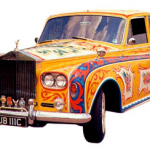
Now for the transport plan: initially, it literally involved thinking “inside the box”. We decided to crate the car, move it on an extra heavy duty, brake-equipped dolly and minimize ground transport risk by flying the vehicle to Montreal. Good plan? No. The proposed crate size would only fit on an “air freighter”; the closest service was Seattle. This meant transporting the crate off the island, where Victoria is located, crossing the border into the US and flying the car back into Canada – a logistical and bureaucratic nightmare. In addition, a second scan of the borrower’s Facility Report revealed that the crated vehicle would exceed the size of their largest receiving door. Feeling more than just a bit unsettled I called our Rolls mechanic to ask for his advice. He suggested contracting a ground transport firm specializing in moving ultra-luxury and multi-million dollar race cars. I madly researched, found and booked such a carrier. A couple of weeks sped by, organizing logistics, loan agreements, insurance. The pickup date was now one week away. Conservation work was progressing well; the worst areas were stabilized but lack of time prohibited completing the work. We had counted on this since the only climate controlled vehicle in the transport fleet had been booked six months beforehand. A frantic call went out to our national conservation institute asking how this type of paint on metal might react to the rapid variations in temperature and relative humidity which the truck and cargo would encounter on the cross-country trek. Weather wise there couldn’t have been a worse month to transport in Canada. The Canadian Conservation Institute responded rapidly indicating the unusual paint formula was ordinarily applied only to wood. However, their final determination, though not definitive, indicated the paint should hold up under these conditions. There was a collective sigh of relief, tempered with unease. I phoned our mechanic. The parts were to arrive Thursday. Thursday? The transport truck would be here early the following Tuesday morning. Can you fix the car in time, I asked hopefully? Shouldn’t be a problem was the response – another hesitant sign of relief.
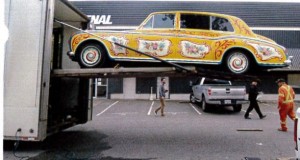
The driver locked the cargo door, sprung into his cab and the cross-country journey began. We maintained regular communication with the driver who reported good conditions until near the end of his journey when the weather forecast threatened the onset of a huge weather system, with high winds and snow predicted to sweep down from the NW on an interception path with his vehicle. The driver recommended pushing on to out run the storm. It was this, or wait out the storm and miss the delivery deadline. Assured he had recently rested we gave the go ahead. 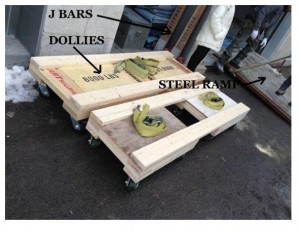
Our Rolls mechanic and head objects conservation, who flew out earlier, explained that hand pushing would damage the body and only one method could be used: driving the vehicle into place. The road was wet and salted, creating the need to cover the path before moving the vehicle. Blankets, plastic, foam packing material was scavenged from the truck and museum but the quantity was insufficient. 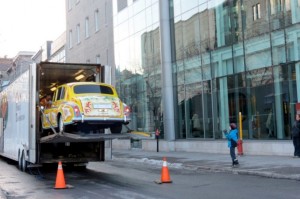
Once in place our mechanic cautiously started the car, backed it out and off of the truck, then maneuvered it down the street to the museum entrance. Then another heart stopping moment – the Rolls looked too large for the entrance. But we knew the entrance size in advance and we used the dimensions of the car provided in the catalogue description. People with tape measures swung into action. With a self-satisfied grin one staff member turned and proclaimed that we had a whole 10 cms of clearance on either side of the car. Some say collections managers are obsessive about accuracy when documenting the size and details related to collections objects. Thank goodness this statement proved true.
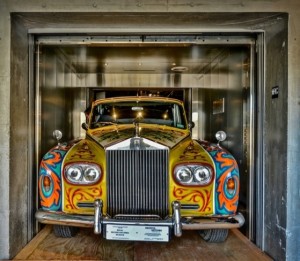
Maneuvering the car rapidly into its exhibit position onto reinforced plates became the next urgent task. Most of the floating floor tiles supported a maximum of 567 kgs while the load on the individual Roll’s tires was 680 kgs each. Almost immediately after the car entered the hall the regular floor tiles showed initial signs of buckling. The car threatened the possibly collapse of the floor. The museum staff flooded down to the carpentry shop returning with sheets of plywood. Hastily the Rolls was driven onto them thereby safely distributing the weight, eliminating the hazard. Now, how can the car be moved into place? A creative solution coupling technology and brute force was concocted. 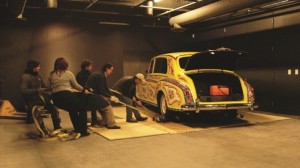
We did it. We made the target date. The car was in place 24 hours before the special opening for the province of Quebec’s two most powerful politicians: the Premier and the Lieutenant Governor.
All of the hard work and planning, backed by brilliantly accurate cataloguing, tempered with innovative problem solving led to the success of this project.
http://pacmusee.qc.ca/en/media/press-releases/john-lennon-s-rolls-royce-at-pointe-a-calliere (history of the Rolls and install)
This is my last article for RegTrek. I want to thank the RegTrek team for their hard work and support and especially Angela Kipp for her energy and enthusiasm in spearheading this brilliant project. I want to wish everyone a fond fairwell as I transition to a new career: teaching English as a Second Language, and ESL material and curriculum development. I wish everyone the best in moving this amazing venture, RegTrek, forward, and I thank you for allowing me to participate.
Best regards.
Derek Swallow, Senior Registrar, Royal BC Museum.
Imagine being asked to transport the most iconic guitar in the world. This is exactly what happened when the guitar belonging to John Lennon was to be transported from Seattle to New York. This blog will explain the journey and what happened along the way.
Great story, good thing you got the job done safely. John Lenon is a great legend. If I had been the owner of that car & someone had even touched it with dirty hands, then I think I might’ve blown a fuse run that guy down with it.
Amazing article and very informative. Great story!!
That was an incredible story, thank you!
Great telling of a fascinating story – thanks for sharing Derek. If the ESL career doesn’t work out you could consider being an author.
Best,
Rob
Wow, Derek, what a story! No wonder you’re taking another job. Makes our upcoming need to move a small covered wagon look like a mere trifle. Best of luck in your new career.